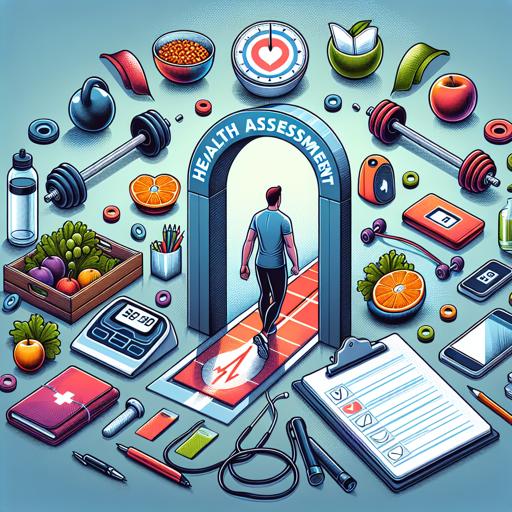Embarking on the path to wellness can be both exciting and daunting, but starting your health and fitness journey: setting realistic goals is the key to long-term success. In a world where quick fixes and fad diets often overshadow sustainable practices, establishing achievable objectives helps create a foundation for lasting change. Whether you’re aiming to improve your physical health, boost your mental well-being, or enhance your overall lifestyle, setting realistic goals ensures you stay motivated and focused.
Join us as we explore strategies to effectively set and achieve your health and fitness aspirations, paving the way for a healthier, happier you.
Understanding the importance of setting realistic goals in your health and fitness journey

Embarking on the odyssey of health and fitness without setting tangible goals is akin to navigating a ship without a compass—it’s charmingly adventurous but bound to get you lost amidst a sea of uncertainty. The art of establishing grounded yet ambitious objectives forms the backbone of any successful fitness endeavor.
When commencing your health and fitness journey, it’s vital to set goals that balance aspiration with realism. It’s easy to thumb through glossy magazines, envisioning the chiseled physiques they promise, but without a tailored blueprint rooted in reality, you risk building castles in the air rather than on a foundation of personal progress. Consider the individual who decides to start running, spurred by a burst of enthusiasm and perhaps a sale on new sneakers.
They dream of conquering a marathon and signing up immediately for such a feat with only weeks to prepare. The inevitable burnout from expectation mismanagement is an all-too-common story. Instead of leaping from zero to marathoner, imagine if our new runner, eyes glimmering with determination, aimed first to triumph in a local 5K.
This initial, more manageable goal, peppered with incremental objectives like consistent weekly mileage and improved timing, serves as a stepping stone, making the endgame of longer races a more attainable reality. It’s these smaller victories that build momentum, endowing our runner with both the confidence and physical stamina to tackle more significant challenges on the horizon.
On a broader spectrum, setting practical targets in your health and fitness quest involves embracing your unique starting point and pace, discerning what truly resonates with your individual desires and capabilities. Rather than being swept up in the tide of comparison, you’re crafting your narrative, one that respects where you’re beginning yet encourages growth. This tailored approach fosters not only sustainable progress but also a sense of satisfaction with each milestone reached.
In this dance with fitness, realism becomes your reliable dance partner, gracefully guiding every step, turn, and leap—ensuring your journey is as fulfilling as it is transformative.
Assessing your current fitness level and health status

Embarking on a health and fitness journey is akin to setting out on an adventure through an uncharted yet familiar land, with both new challenges and exciting discoveries waiting to reveal themselves. Understanding your current fitness level and health status is the trusty compass that guides your path, ensuring you don’t set sail on a turbulent course without the proper equipment.
Before leaping into goals that resemble scaling Mount Everest in flip-flops, one must engage in an honest introspection of their body’s current strengths, weaknesses, and potential. This is not just a matter of confronting those extra pounds accused of hibernating through winter but an opportunity to take a holistic view of where you stand in terms of cardiovascular health, muscle strength, flexibility, and endurance. For instance, can you sprint to catch the bus without wheezing like a harmonica, or does bending to touch your toes feel like an elusive Olympic event?
Each of these insights pieces together a comprehensive map of your present physical condition, forming the cornerstone of your journey. With this newfound clarity, the stage is set to craft realistic and attainable goals that inspire steady growth rather than swift frustration.
Setting ambitions that are as attainable as capturing stardust might sound enchanting, but both you and I know the cosmos are best left to astronauts. Instead, it’s wiser to aim for something grounded yet transformative, like running your first 5K or mastering a set of push-ups without resembling a floundering fish. The key is to outline clear, measurable objectives that can evolve with you, offering tangible progress rather than fantastical daydreams.
By planting seeds of achievable aspirations, you nourish the kind of motivation that blossoms into a lifelong devotion to health and fitness. This journey, like any well-composed symphony, harmonizes the reality of your starting point with the rhythm of incremental improvement, ultimately playing out as a triumphant melody celebrating personal success.
Crafting smart goals: specific, measurable, achievable, relevant, and time-bound

Embarking on a health and fitness journey often resembles setting sail on uncharted waters, where enthusiasm is your wind and a plan is your compass. However, without clearly marking out your course with precise milestones, you’re likely to find yourself adrift.
Enter the world of well-structured goals, the kind that are not only dreamed of but are effectively realized using the magic formula of specificity, measurability, achievability, relevance, and time constraints. Imagine setting a goal not simply as „I want to get fit,” but rather as „I will complete a 5K run in 30 minutes by the end of six months. ” This articulation doesn’t just identify the destination but maps out the entire route with landmark precision.
Specificity ensures you aren’t lost in the vast sea of ambiguity. It’s akin to swapping a vague notion of „getting healthier” for a concrete aim like increasing your daily water intake to 3 liters.
Measurability steps in to quantify progress, infusing your undertaking with encouraging feedback. Instead of vaguely trying to „improve stamina,” tracking endurance with timed exercises offers tangible proof of progress. The achievability parameter brings a reality check to your aspirations, acting as a lighthouse that realigns goals with your current capabilities, encouraging steps like starting with a realistic weight loss goal of 1-2 pounds per week.
Relevance roots goals in personal motivation, reminding you why it matters to enhance your energy levels for the stamina required in daily parenting marathons. Lastly, tying it all together, time-bound elements create a thrilling deadline-driven narrative, ensuring your aspirations don’t drift eternally on your to-do list but rather sail swiftly to completion. In all this navigational planning, the ultimate mastery is in crafting goals that resonate on a personal level.
With each specific and measurable target, you’re essentially constructing a personalized roadmap that transforms a fleeting dream of better health into a series of deliberate, strategic actions. The sense of achievement not only lifts your spirits but also powers forward momentum on your fitness odyssey, giving you a robust framework to celebrate small victories often overlooked on the journey to personal wellness.
Whether you’re just beginning your quest to shed old habits or lifting self-imposed limits, starting with realistic goals is not just the anchor to your ambitions but the wind in the sails that propels your adventurous voyage toward a healthier, fitter self.
Overcoming common obstacles and staying motivated
Embarking on the quest for better health and fitness is much like training for a mythical journey. It requires a map, a purpose, and a sprinkle of determination.
The pivotal phase in this voyage is setting goals that are not only achievable but also inspiring. Many find themselves entangled in the web of idealized visions—yearning for six-pack abs in a week or preparing for a marathon with only a month of half-hearted jogging behind them. The secret lies in the magic of realistic goal-setting.
Imagine sculpting a masterpiece from clay; it requires patience, precision, and an unwavering hand. Start small, perhaps by aiming for thirty minutes of physical activity five times a week, or choosing wholesome, nutrient-rich meals at least three days out of seven.
These modest, yet progressive, goals provide the foundation for a sustainable fitness journey. Now, as romantic as setting realistic targets sounds, the road is rife with obstacles that can sap motivation quicker than you can say ‘quinoa smoothie’. There are days when the couch whispers sweet nothings louder than the gym door beckons.
The clever counter to such sabotage is to craft your environment and routine such that motivation barely gets a chance to dip. Track your progress with a journal—noting not just the milestones, but those endearing stumbles too.
Find a workout buddy whose alarm snooze battle parallels yours, but whose energy ignites yours once the rubber hits the road. Celebrate small victories, like the extra rep you didn’t skip or resisting that extra donut. These fragments of success become the stars guiding your journey.
This dynamic blend of goal setting and motivational tactics not only builds resilience but transforms the health and fitness road to one marked with joy and personal triumphs, no matter how small.
Tracking progress and adjusting goals for long-term success
Embarking on a health and fitness journey is akin to setting sail on the high seas—navigating through the ebbs and flows with a compass calibrated by realistic objectives. It’s not merely about envisioning a sculpted physique or envisioning endless stamina. Rather, the essence lies in crafting goals rooted in pragmatism and personalized metrics of success.
Akin to an artist selecting a palette, one must choose goals that invigorate yet are attainable. This exercise in grounded ambition ensures the journey remains gratifying and sustainable.
By avoiding the all-too-common pitfall of overreaching—a rookie mistake as predictable as the tides—individuals pave a trajectory dotted with achievable milestones rather than elusive mirages. The art of tracking progress commences by recognizing that each step forward is a triumph in its own right, much like a carefully choreographed dance.
By maintaining a journal or employing apps that meticulously record every calorie or mile, individuals become the captains of their own ships, steering with precision toward their ultimate goals. This vigilant record-keeping acts as a feedback loop, enabling one to modify aspirations as circumstances evolve—a game of strategy akin to a chess match where adaptability is king. Just as a seasoned sailor adjusts the sails in response to shifting winds, those on a fitness journey adjust their course to maintain momentum and harness the winds of progress to their advantage.
Each recalibration not only signifies growth but also fortifies commitment to the larger quest for wellness. This meticulous monitoring isn’t an exercise in vanity; it’s a deliberate strategy to ensure longevity in one’s health endeavors. An approach characterized by flexibility, allied with resolute motivation, enables an individual to embrace the unexpected challenges that invariably arise—whether it’s a sprain from an overzealous workout or a setback imposed by life’s inevitable obligations.
The anticipation and adaptation to these disruptions metamorphosis one’s health and fitness experience from a temporary interest to a deeply embedded lifestyle choice. Ultimately, the triumphant journey toward well-being is defined not by the absence of deviation from a set path, but by the capacity to deftly realign one’s goals and persist, much like a seasoned sailor forging onwards despite the tempest.
Nasza rekomendacja wideo
Podsumowanie
Embarking on a health and fitness journey requires setting realistic goals to ensure sustainable progress. Begin by assessing your current fitness level, then establish specific, achievable targets. Break down larger goals into smaller milestones to maintain motivation.
Remember to celebrate each success and adjust your plan as needed. Consistency and patience are key to transforming these goals into lifelong habits.
Najczęściej zadawane pytania
What are the key steps to setting realistic health and fitness goals for beginners?
The key steps to setting realistic health and fitness goals for beginners include assessing current fitness levels, defining specific and achievable objectives, creating a structured plan, and regularly tracking progress while remaining flexible to adjust goals as needed.
Sure, please provide the question you’d like me to answer.
How can I assess my current fitness level to set achievable goals?
To assess your current fitness level and set achievable goals, you can evaluate your performance in key areas such as cardiovascular endurance, muscular strength, flexibility, and body composition through simple tests like a timed mile run, push-up and sit-up counts, sit-and-reach test, and measuring your BMI or body fat percentage.
Sure, please provide the question you’d like me to answer.
What are some common mistakes people make when setting fitness goals, and how can they be avoided?
Common mistakes in setting fitness goals include setting unrealistic expectations and lacking specificity, which can be avoided by setting achievable, measurable, and time-bound objectives.
Sure, please provide the question you’d like me to answer.
How can I ensure my health and fitness goals are specific, measurable, achievable, relevant, and time-bound (SMART)?
To ensure your health and fitness goals are SMART, clearly define what you want to achieve, quantify progress with metrics, set realistic targets, align them with your broader life objectives, and establish a deadline for completion.
Sure, please provide the question you’d like me to answer.
What role does mindset play in setting and achieving realistic fitness goals?
Mindset plays a crucial role in setting and achieving realistic fitness goals by fostering a positive attitude, resilience, and motivation, which are essential for overcoming challenges and maintaining consistency.
Of course! Please provide the question you’d like me to answer.
How can I track my progress effectively to stay motivated on my health and fitness journey?
Track your progress effectively by setting specific, measurable goals and regularly recording your achievements using a journal or fitness app to visualize improvements and stay motivated.
